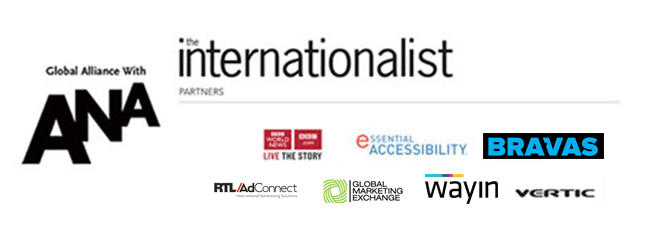

Doug Wood
See the current issue
of The Internationalist magazine
Find out how to sponsor an issue of Trendsetters
|
|
Trendsetters: The Top 10 Legal Concerns Marketers Will Face in 2018, According to Doug Wood of Reed Smith
Doug Wood is an attorney who unquestionably understands the concerns of marketers worldwide. In addition to his role as partner at Reed Smith, LLP, and chairman of its advertising, technology, and media group, he's general counsel for three different organizations: the Association of National Advertisers, Inc., the Advertising Research Foundation, and the Advertising Council. He's also the founder and past chairman of the Global Advertising Lawyers Alliance, author of the long-standing text book-- Please be Advised, a Legal Reference Guide for the Advertising Executive, and a popular novelist.
Given the changing regulatory landscape for brands this year, Doug Wood believes that "2018 will provide no shortage of headaches for brands and agencies."
Here are his top 10 legal issues of concern to marketers in the coming months:
1. Transparency 2.0
"No doubt many media buying agencies and brands are tired of hearing about transparency," says Wood, "but whether they like it or not, it's not going away. In fact, the issue of transparency is only going to expand."
He believes that the unacceptable behavior of the past in traditional and digital media is seeing a rapid sunset. "In 2018, we'll see transparency expand into promotion and experiential marketing as well—areas that reportedly match or even exceed traditional and digital expenditure. Brands will do even more to monitor their supply chain for all areas of the marketing ecosystem. Globally, annual spending on traditional and digital media, promotion, experiential, public relations, etc., may well exceed $1 trillion."
He also predicts that the strategy adopted by some in the marketing community to deny, delay, and disguise will become a new demand for disclosure, data, and discovery.
2. Digital Accountability
Wood emphasizes that despite declarations to the contrary, log-level data is indeed available from the demand-side platforms (DSPs) in the digital supply chain, according a study jointly conducted by the ANA, the Association of Canadian Advertisers, Ebiquity, and consulting firm AD/FIN. Arguments to the contrary-- that the data was proprietary, inaccessible, or subject to non-disclosure agreements-- were revealed as red herrings once the brands that participated in the study made it clear they would not accept excuses.
He adds, "In 2018, expect to see more brands demanding full access from their DSPs. Claims that log files are not available to advertisers are empty."
3. Data Protection in Europe & China. Hello to a New C-Suite Member!
While most marketers have heard about the impending May adoption of the European Union's General Data Protection Regulation (GDPR) and the e-Privacy Directive that will soon follow, numerous surveys indicate that brands and the supply chain are not prepared.
"With fines as high as 4 percent of global turnover, brands need to appreciate that the buck stops with them," says Wood. "They are the ultimate targets. Traditional contractual indemnities and reliance on suppliers will no longer cut it."
He outlines how non-compliance may have major implications for brands:
- Data on customers presently in the hands of brands may be poisoned and no longer legally available for use.
- Brands might be banned for some period of time from dealing with EU consumer data at all.
- Data aggregation may be a relic of the past unless consumers opt in to co-mingling of data.
He adds, "And say hello to the newest member of your C-suite, the data protection officer (DPO). If the GDPR applies to a brand, it must appoint someone to that role with the mandate that he or she report to the highest levels of the brand and conduct annual assessments of risk and compliance. The DPO cannot be fired for doing his or her job, so there is an element of whistleblower protection as well."
If GDPR weren't enough of a headache, China's data protection legislation becomes fully effective at the end of 2018. In addition to fines and revocation of business licenses, the penalties in China include imprisonment. "So," says Wood, "if you're a brand manager in China, you may want to start saving some bail money."
Yet, he believes there could be a silver lining amid such sweeping data regulation. "One possible result of the GDPR is better alignment of brand spend and accountability, and greater control over data by advertisers."
Doug Wood also wonders if the European model will become the global default approach to data collection and use. "If it does," he says, "the change is dramatic when compared to how U.S. marketers are currently regulated."
4. Bots Plague the Digital Landscape
Non-human traffic is skimming billions of dollars from the brand community's investments. Industry consultant White Ops has now completed three studies for the ANA to find ways to minimize the non-human intrusion.
According to Wood, "This black eye has done more to damage digital spend than any other factor. At least one major marketer cut back spending by millions in 2017 and reported it had no negative effect on the impact of its marketing. Others followed. In 2018 this trend can be expected to continue as brands begin to question their commitment to digital and the failure of the supply chain to solve the fraud epidemic. The argument that because impressions are so cheap, brands shouldn't care won't work in 2018."
5. Brand Safety Patrol
As if the plague of bots wasn't bad enough, brand safety was a major concern in 2017. "Some think it is even more important than fraudulent, non-human traffic," says Wood. "Being associated with reprehensible websites or digital purveyors goes to the heart of a brand's integrity and good will. Bots only waste money."
The issue of whether brand safety can be assured remains a center of great debate. He continues, "Some say there is no effective technology solution and that digital publishers cannot afford the manpower to monitor and weed out offensive associations. Unless that discussion turns from debate into solutions, brands in 2018 will have more reason to move away from digital and back to traditional media."
6. Weeding the Walled Garden
There was much talk in 2017 about walled gardens at Google, Facebook, and other digital publishers that are allegedly preventing brands from fully accessing details of their advertising investments. That has been coupled with headlines that have questioned the accuracy and integrity of some analytics from behind those garden walls. According to Wood, "The Media Rating Council is trying to work out more transparency and accountability with the providers, and 2018 will reveal how far providers are willing to let brands get into the digital weeds."
7. DOJ and Bid Rigging
In 2016, the U.S. Department of Justice made headlines when it acknowledged there was an investigation into bid rigging in commercial production. The revelation brought back memories of a similar investigation in 2002 that led to prison terms for some ad agency executives.
Press reports indicated that in 2017 a number of the advertising agency holding companies were subpoenaed in the investigation. "Since then," says Wood, "everything has gone silent and no further word has come from the DOJ. One has to believe that this investigation, one way or the other, will conclude in 2018."
8. NAAG's Focus on Children & the Elderly
The National Association of Attorneys General has announced a 2018 focus on advertising and marketing directed to children and the elderly. While the industry has a robust self-regulatory regime for children's advertising, no such specialized unit exists for advertising to the elderly.
"As more baby boomers enter their golden years," says Wood, "there will undoubtedly be more pressure to protect that growing population from deceptive and unfair advertising practices. Since the FTC is unlikely to step in any time soon, welcome to regulation by 50 states. That's a letter of inquiry no one wants to receive."
9. Where in the World Is the Federal Trade Commission?
There are currently two active commissioners on the Federal Trade Commission, one of whom is sitting beyond her statutory term. The commission is supposed to have five commissioners. President Donald J. Trump has nominated a new chair but confirmation has not been completed.
Despite having just two sitting commissioners, Doug Wood doubts that the FTC will be a "paper tiger" in 2018. He's outlined a list of actions to look out for from the FTC in the coming months:
- There will be an increased focus on the nature of any consumer injury, particularly from the perspective of data privacy. The FTC will look for cases where there is a quantifiable or measurable injury rather than sheer speculation.
- In the area of national advertising, the FTC will be reluctant to seek monetary redress merely for failure to possess and rely upon a reasonable basis when making claims. That's good news.
- The commission will tend to bring cases seeking monetary relief in more serious fraud cases and will refrain from such demands in cases where the issue is one of substantiation.
- The FTC will be cognizant of how its actions — particularly consent orders — have the potential to "chill" truthful speech, particularly in emerging business areas. For example, in 2018 the commission will consider whether the restrictions on speech could have an unanticipated impact on certain types of technological developments.
- The FTC is poised to litigate more cases administratively rather than in federal courts. The commission will likely rely on its administrative courts to raise important issues and through the decisions establish industry-wide principles and guidance, as they did in the 1980s for standards governing deception, unfairness, and substantiation.
- The approach is in lieu of seeking monetary damages. As Acting Director of the FTC's Bureau of Consumer Protection Tom Pahl described it: an exercise of "prosecutorial discretion to seeking monetary relief in advertising substantiation cases only if the advertiser engaged in dishonest or fraudulent conduct."
10. Power to the Brands
Doug Wood notes that the biggest story for 2018 will at first not seem to be a legal one at all. "The ANA has called for brands to take back control of the ecosystem, long relegated to the supply chain. This year the momentum of brand control we saw in 2017 will accelerate. This will mean new contracts, greater accountability, increased transparency, movement to in-house operations, and more. Like it or not, the chaos that will follow is grist for the legal mill."


